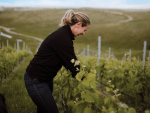Getting Dinner Done
Australia-based French chef Manu Feildel has teamed up with Ingham’s NZ to launch the poultry producer’s Dinner Done campaign.
Stories are what sell your wine.
Creating an effective wine story is an easy feat for large wine brands with skilled public relations and marketing departments. But for small and medium-sized wineries, it's often a challenge to convey how your $20 bottle of Chardonnay is different from the $20 bottle sitting next to it.
Your wine story is more than your tasting notes, and it's more than your region. It's who you are as a brand and why you exist. It's your logo, your label, and your packaging. It's your website. It's what you tell people at the cellar door and what you tell distributors.
Why do some people fail at telling their wine story, when others succeed?
Many wine brands try to be everything to everybody. This lack of focus often hurts your storytelling ability and it muddles a consumer's decision-making process when deciding to try (and re-buy) your product.
For example, when you tell consumers your wines are both "acidic and fruity" or "have a subtle start and lead to a boisterous finish", you confuse them. Also, the use of the word "complex" is somewhat of a backpedal if you don't specifically explain how your wine is complex. In these instances, rather than thinking your wine is "everything", consumers will think it is "nothing in particular".
Region and terrior are important, but not as much as you think. Too often wine brands rest on winery location to convey their story to consumers. It is vital that people know where a wine is from, but this is only to pique initial interest.
Awards, stars, and ratings are often over-promoted. While a 90+ rating or four and a half stars is a major feat for the winery itself, consumers see nothing but high ratings and multiple stars when they look at wine shelves. There's so much more to your wine story than what a panel of judges think.
A lack of authenticity in a wine story is the key factor in a wine story that falls short. Contrived stories about the history of the product and the winemaker that exaggerated the facts, sound twee or overly sentimental, or don't match up to visual branding lead to a disinterested audience.
Remember, the purpose of telling your wine story is not to persuade with overemphasis, but to persuade with nuanced fact.
In telling a good wine story, you need to be able to articulate who you are. Why does your brand exist? Why are you still in operation today? Where does your passion come from? Who are the people behind the cellar door? These aspects will give your wine story a clear narrative vision.
You also need to be able to convey why you're different to your neighbours. Where are your grapes from? Why are your varietals worth interest? What unique viticultural techniques are you using? How small or large are your vintages?
Who you are and why you're different are the essential things every single person in your business should know. These parts of your story can be told on your website, to media, at the cellar door, and whenever you meet anybody and need to talk about your wine. Think of it as your "elevator pitch": the succinct and persuasive story you can tell in under two minutes, or 300 words.
Your wine story needs to continue with every bottle. You don't have space for much of the above on a label; remember that the real estate for words on a bottle is extremely limited. Instead, you need to convey your wine story all in your imagery. Your logo, label colours and designs, and fonts used should all be cohesive with the story you can tell verbally or in writing.
In the text that does feature on your labelling, focus on your story, not just your wine region. If you include abbreviated tasting notes on your labelling, ensure they fit within your wine story's overall narrative.
Whether it's on your bottle, on your website, or when you're actually talking about your wine in an elevator, the most important part of your wine story is emotion. How does your wine make the consumer feel about both buying and drinking it? Is it a status wine? What kind of people enjoy it? What feelings does it conjure up? How does all of this relate to the people behind the wine? Leave your consumers with an emotional message about what you represent.
The purpose of this is to engage with consumers. You need to connect with them and demonstrate how and why your brand is relevant and worth their time. The wine itself, of course, is the physical manifestation of that engagement.
To foster and continue such engagement, your wine story can be brought into the 21st century with social media tools. Facebook, Twitter, Pinterest, Instagram all have value for wine brands, as they give the opportunity to continually, yet subtly, tell your story over and over again.
Use social media for posting "peripheral" information to convey your wine story, and keep the direct promotion to a minimum.
For example, for every one post about a new vintage being released, balance this with four other posts that aren't specifically about your product.
Keep your social media profiles fresh and interesting, and, naturally, in line with your wine story. In doing so, it's a story that will never get old and tired.

OPINION: Harvest begins, and almost immediately we start to get media enquiries about how the vintage is going and whether it…

OPINION: Rachael Cook is the smiling grape grower on this month’s cover, tending vines on the miniscule, beautiful and dream-driven vineyard…
New Zealand wine enthusiasts have a deepening understanding and growing appreciation of sparkling wine, says Mel Skinner, Chair of Méthode Marlborough…
One of the biggest mistakes wine marketers make is in assuming consumers are as passionate and knowledgeable about wine as…
Taking two sustainability awards at two events on a single evening felt like "true recognition" of the work Lawson's Dry…